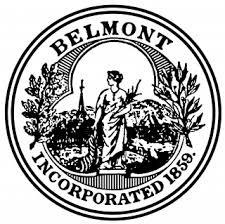Belmont Annual Town Election to be Held Tuesday, April 3
Each year the Belmont Citizens Forum asks candidates for selectman about issues the town will likely face in the next three years. This year Tom Caputo is running uncontested for the seat currently occupied by Jim Williams, who is retiring after one term. Below are Caputo’s unedited replies to our questions about the environment, traffic, funding, and planning.

Tom Caputo
1. How would you address the amount of cut-through traffic in Belmont?
Cut-through traffic in Belmont has always been bad, but it has significantly worsened with the development of GPS apps like Waze and Google Maps. The Board of Selectmen asked the Traffic Advisory Committee (TAC) to develop a set of proposals to address cut-through traffic on a town-wide basis—with strategies that could be employed quickly and cost-effectively. TAC has engaged a consultant to assist in the analysis. On February 8th, the consultant outlined a plan which includes quantifying the traffic patterns through town and identifying where those cars come from (Belmont or beyond). Through the strategic deployment of turn restrictions, for example, we could influence the route guidance that GPS apps give to commuters, thereby making Belmont a less attractive commuting alternative. The study is expected to last several months, and I am eager to see the recommendations that come out of the process.
2. What do you see as the most important steps for constructing the Community Path, and how quickly can we complete it? Do you believe it should be integrated into the high school redesign/intergenerational path redesign?
The Community Path has been a feature of every design plan created by the High School Building Committee architects, and it will significantly enhance biking and walking options to school. Implementation of the path, however, is separate from the high school project. The Community Path Implementation Advisory Committee (CPIAC) developed a final route proposal that was approved by the Board of Selectmen last December. The Board asked CPIAC to take the next steps in the process—identify state/federal funding sources for the construction of the path and work with the MBTA and property owners to address outstanding route design questions. In addition, the town must identify a funding source for the design phase. It is likely that we will want to phase the design and construction, given our concurrent building projects and the potential disruption of a town-wide construction project.
3. How can we prepare for increasingly intense storms and climate-related sea-level rise, and specifically for flooding in the areas of Little River/Alewife Brook, Little Pond, and Clay Pit Pond? What opportunities do you see for Belmont to coordinate with Cambridge and Arlington to increase resiliency to the predicted flooding?
Climate-related sea-level rise and growing storm intensity represent challenges for Belmont, but also the region, the state, and ultimately the world. Preserving floodplains and open space gives water a place to go. Minimizing the creation of new paved surfaces reduces runoff. We must use best management practices in our communities to recharge water, from installing rain gardens, vegetated buffers, pervious pavement, and swales, to more complex detention basins to meet stormwater permits in new developments. The design team for the High School Building Project has been closely examining predicted flood level data and has worked to situate the new proposed high school building on the site to minimize the likelihood of flooding. Belmont can learn from recent regional analysis such as the Cambridge Climate Change Vulnerability Assessment, and explore ways to coordinate such efforts across the region.
4. Like Arlington, should Belmont consider joining the Metropolitan Mayors Climate Preparedness Task Force of the Metropolitan Area Planning Council (MAPC)?
I strongly support collaboration with our neighboring communities to address the regional issue of climate preparedness. The Metropolitan Mayors Climate Preparedness Task Force was created in 2015 as a coalition of fourteen cities and towns (e.g. Boston, Cambridge, Somerville, Newton, etc.) to exchange information and create regional solutions regarding the impacts of climate change. The communities have committed to regional goals by 2050, in addition to each community implementing three new projects by 2020. Belmont approved a Climate Action Plan in 2009, with a carbon emissions reduction goal of 80% by 2050, but we are currently lagging behind in progress toward our goals and could learn much from the experience of other cities and towns.
Belmont approved a Climate Action Plan in 2009, with a carbon emissions reduction goal of 80% by 2050, but we are currently lagging behind in progress toward our goals and could learn much from the experience of other cities and towns.
5. What are your environmental priorities for Belmont?
Belmont must continue our work toward achievement of the Climate Action Plan Resolution adopted by Town Meeting in November 2009. A critical component of meeting the Plan’s targets is the reduction of Belmont’s carbon dioxide emissions through Belmont Light’s purchasing of power from renewable sources. Second, we must consider “total lifecycle costing” when designing the new Belmont High School project and make energy efficiency, including the consideration of Zero Net Energy options, a high priority in building design and operation.Third, we should continue to promote the adoption of renewable energy technologies by the Belmont community through programs like Belmont Goes Solar and Belmont Drives Electric.
6.What do you think is a reasonable goal and timetable for reducing pollution in Belmont’s streams and ponds so they can support recreation like boating or even swimming?
In the last decade, Belmont has spent over $8 million replacing deteriorating sanitary sewer mains, but there are still service connections (links between houses and the sewer mains) that require lining or replacement to minimize leaks. In May 2017, the town of Belmont signed an agreement with the EPA to address the ongoing discharge through our stormwater drains of sewage that makes its way into the Mystic River watershed and ultimately Boston Harbor. The EPA agreement sets out a timetable stipulating that Belmont find and remediate the sources of sewage infiltration within five years. Consultants will soon issue a report based on their study of three major outfalls into Little Pond, which will guide our next steps. I am supportive of the town’s commitment to the five year timeline outlined in the EPA agreement.

Selectman Room (Ann Coit Sifneos)
7. Do you support introducing a stormwater fee to ensure adequate funding of the major work remaining to detect and repair our aging underground infrastructure?
Belmont has two ratepayer structures – one for clean drinking water coming into the home, and another for the disposal of sewage water coming from the home. Currently, the work Belmont is doing to clean up our stormwater is funded through the sewer enterprise fund, either directly or through borrowing. Some communities have created independent stormwater utilities dedicated to funding stormwater management. Unlike sewer and water rates, which are based on metered usage, stormwater fees are often based on other factors, like the amount of impervious surface on the property (e.g. roofs, parking lots, driveways). Belmont should explore the possibility of creating a stormwater utility, how the rates would be determined, and whether it is a more effective source of funding than our current approach.
8. Belmont has a reputation for putting town studies on a shelf and ignoring them. What do you believe town government should do to see that these plans are considered?
Belmont is fortunate to have a community of volunteers willing to give their time and expertise to study important town issues. The analysis and recommendations from these groups should be actively considered, and where appropriate, implemented by Town Meeting, the Board of Selectmen, and the town administration. We should have an inclination to action when thoughtful recommendations are made, but often the town is challenged by limited staff or financial resources. To that end, I believe the Board of Selectmen must be the drivers of action. The Selectmen must work collaboratively with the community to decide the town’s strategic priorities (often guided by these studies) and then must ensure town staff and resource are focused accordingly.



Sorry, the comment form is closed at this time.